An exceptionally moving travel experience
Since 2016, I’ve written more than 160 posts exploring the exceptional places I’ve seen in the deep heart of France, so I don’t say this lightly: the Château de Commarque is unique among the most moving experiences I’ve had traveling in this region. I’ve taken hundreds of detours down country roads and visited dozens of other old castles over the last 25 years; by my count, I’ve written about 34 of them just for this blog. But after a while, many of them start to look similar – they are piles of rocks where the outlines of a castle remain, perhaps, or slightly shopworn old family manors.
Don’t misunderstand -- just about every château is interesting in some way. But only a few have had both the visual impact and the historical gravitas to take my breath away and ignite my imagination about their past. The grand pair of rival châteaux at Beynac and Castelnaud-la-Chapelle comes to mind, or the impressive ruins of Polignac sailing like a clipper ship on a basalt plateau, or the massive fortress at Murol – all among the most impressive places I’ve seen.
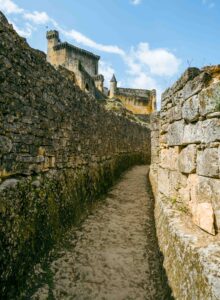
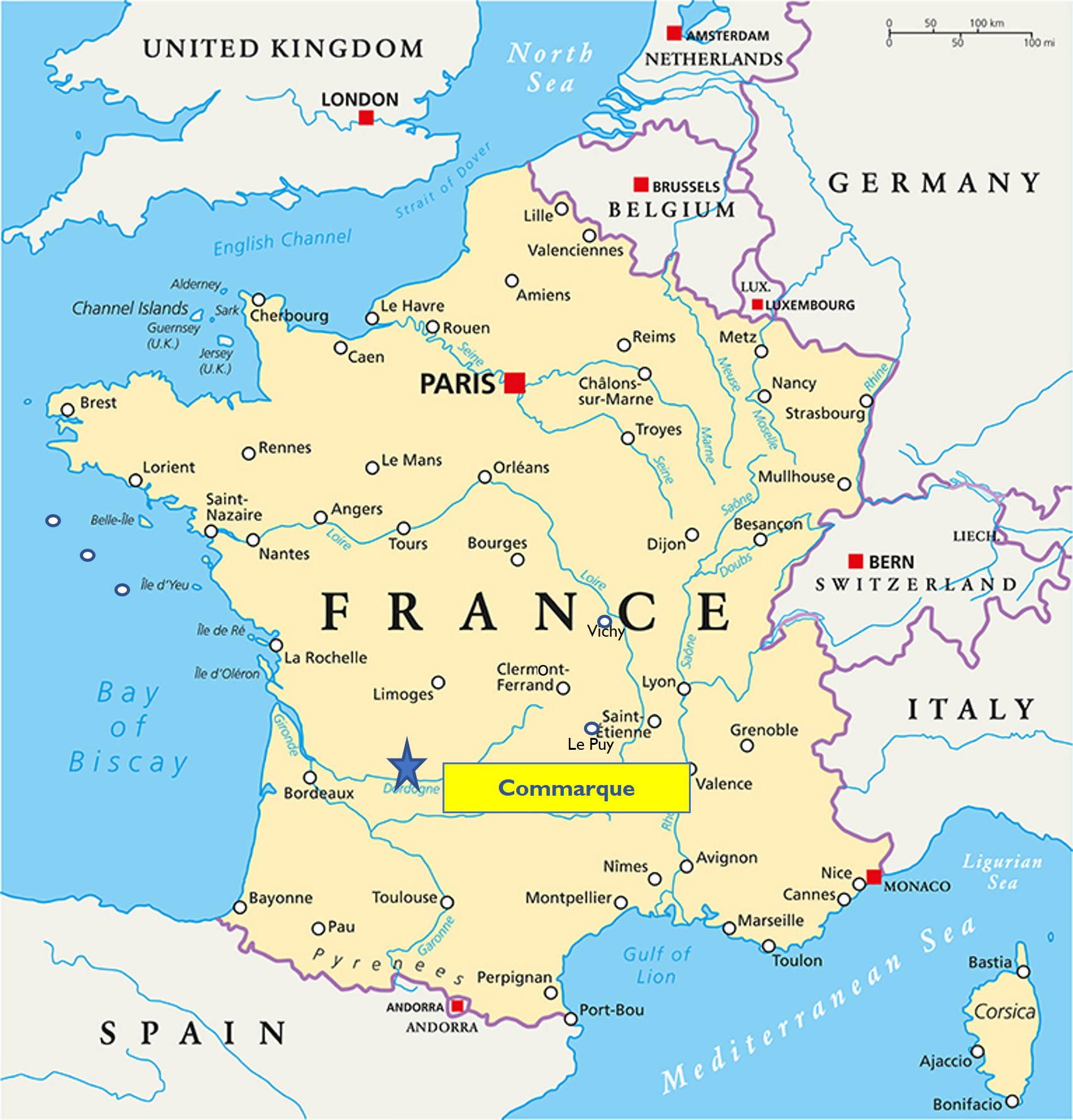
Taking the D road to Commarque
But nothing really prepared me for what I found when I set out one summer afternoon to find the Château de Commarque. I knew what I had read about it in novels and guidebooks, and I knew some of its reputation among archeologists and historians. But I had not really understood how massively imposing it is at first glance. I had not understood completely how deep its history is, reaching back to the first appearance of humans in France. And I certainly was not ready for the impact it had on me as I climbed up and down its slippery paths, each level exposing some aspect of that history and the incredible restoration project that has brought it all back from certain destruction.
As is so often the case in central France, getting to some places – even one as important as Commarque -- means navigating scarily narrow “routes départementales”, or “D roads“, and wondering at times if you really are still on the right path. (When France Bleu did a story on the Château in 2020, they said, “Getting there is simple: get a helicopter”.) In this case, the road struck me as particularly rough, and I once again observed the enduring mystery of how you can drive for 20 or 30 minutes at a time without ever seeing another car, only to arrive in a parking lot that’s almost full!
Once you’re out of the car, there’s a steep half-mile walk down to the site of the château. (And of course, as you’re walking down you have to remember that there will be a steep uphill climb at the end of your visit, although the whole trail is well-shaded by trees that are 60-80 feet tall.)
But when the end of the trail opens out onto the castle site…oh, my! This is one of the most spectacular ruin sites I’ve seen anywhere. The many buildings that make up Commarque climb a sharp limestone hill above a broad green meadow.
At its base (and in the rock wall facing the castle across the meadow) you can see several cave openings, hinting at epochs long before the medieval construction. And the meadow in between is lush, bucolic, populated with cattle and hikers making their way around the site. Another castle – the 13th-century Château de Laussel – is visible on a nearby hill (although signs at the ticket booth here make it clear that “you can’t visit it – it has hotel rooms available for week-long stays, but the path from here to there is private”).
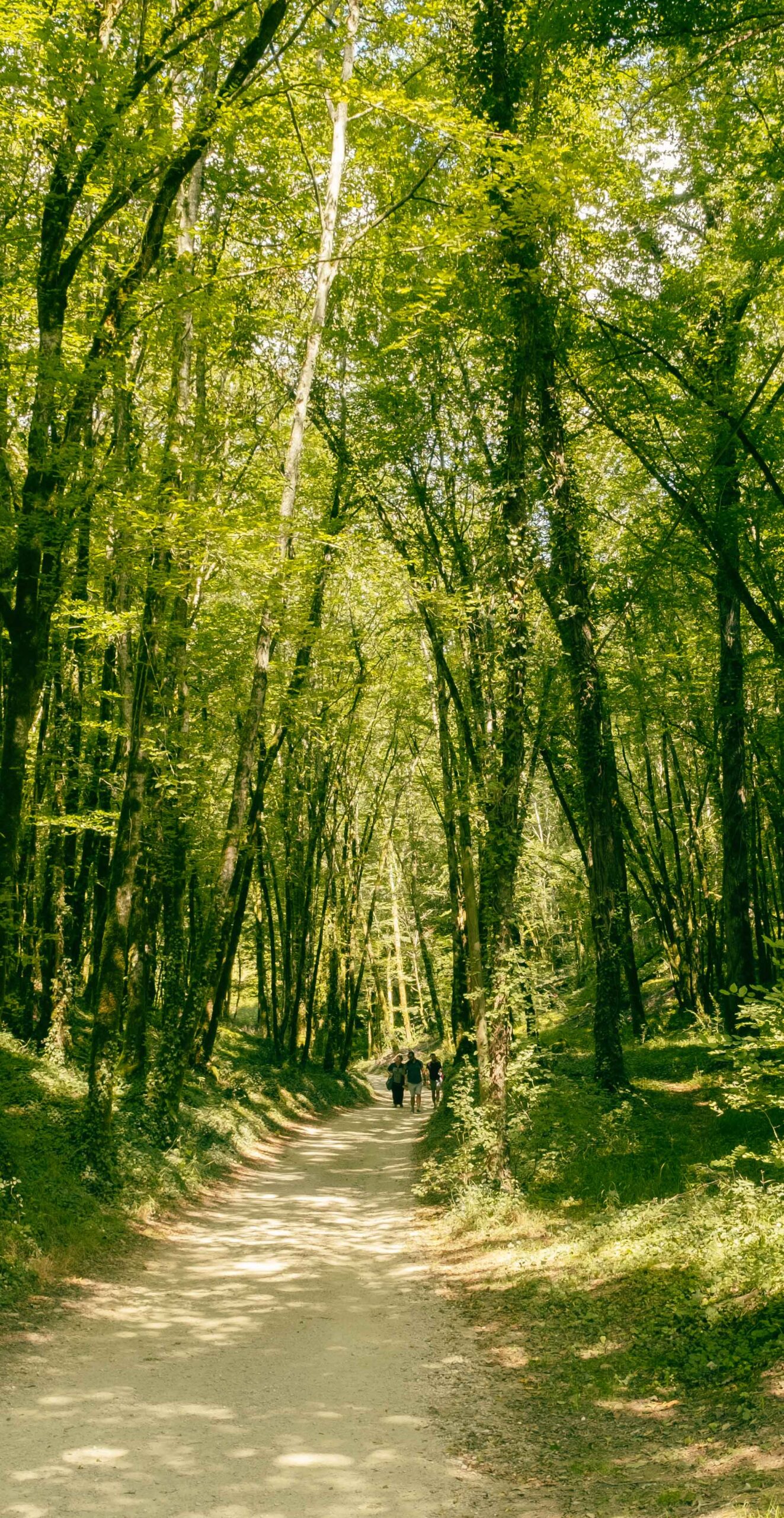
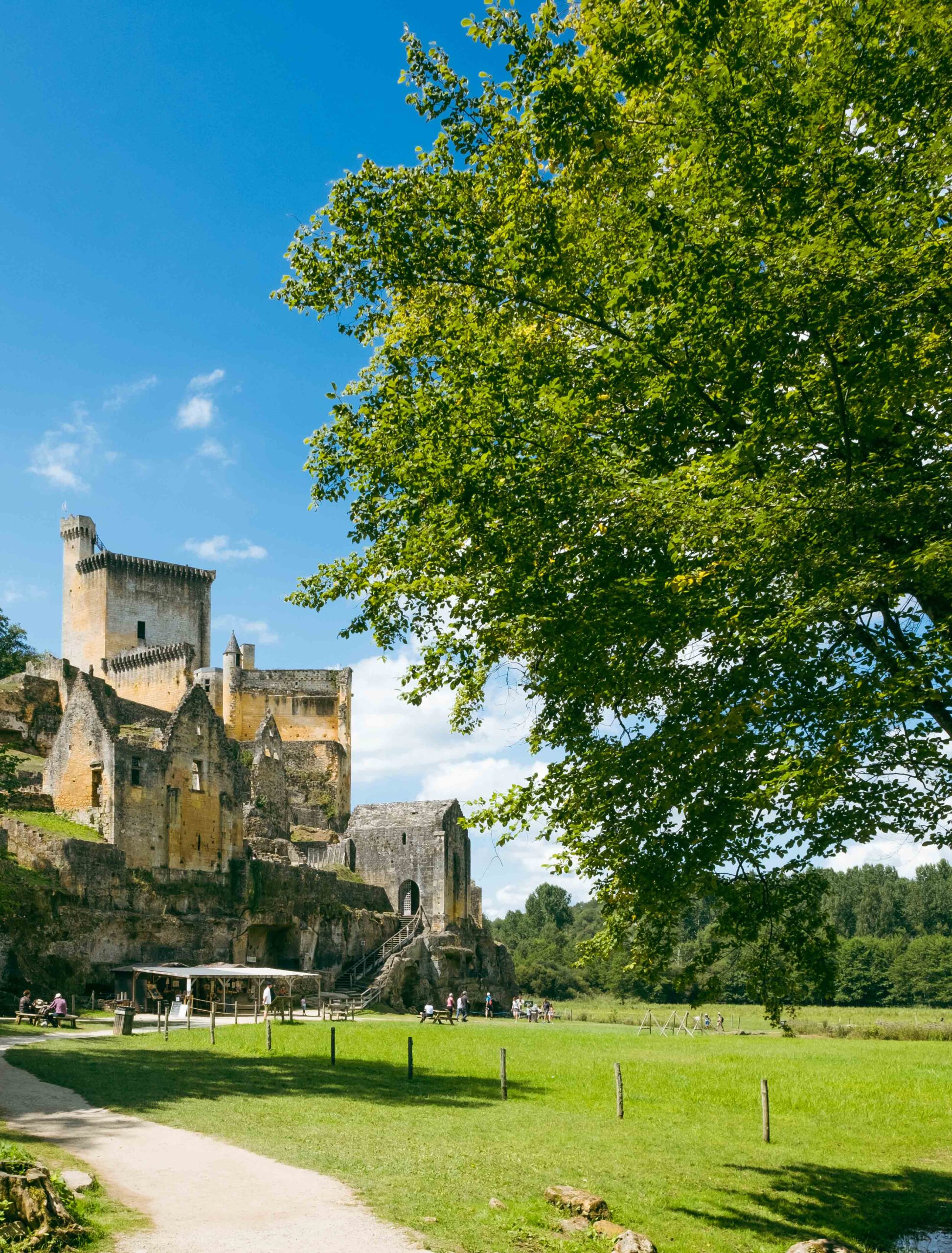
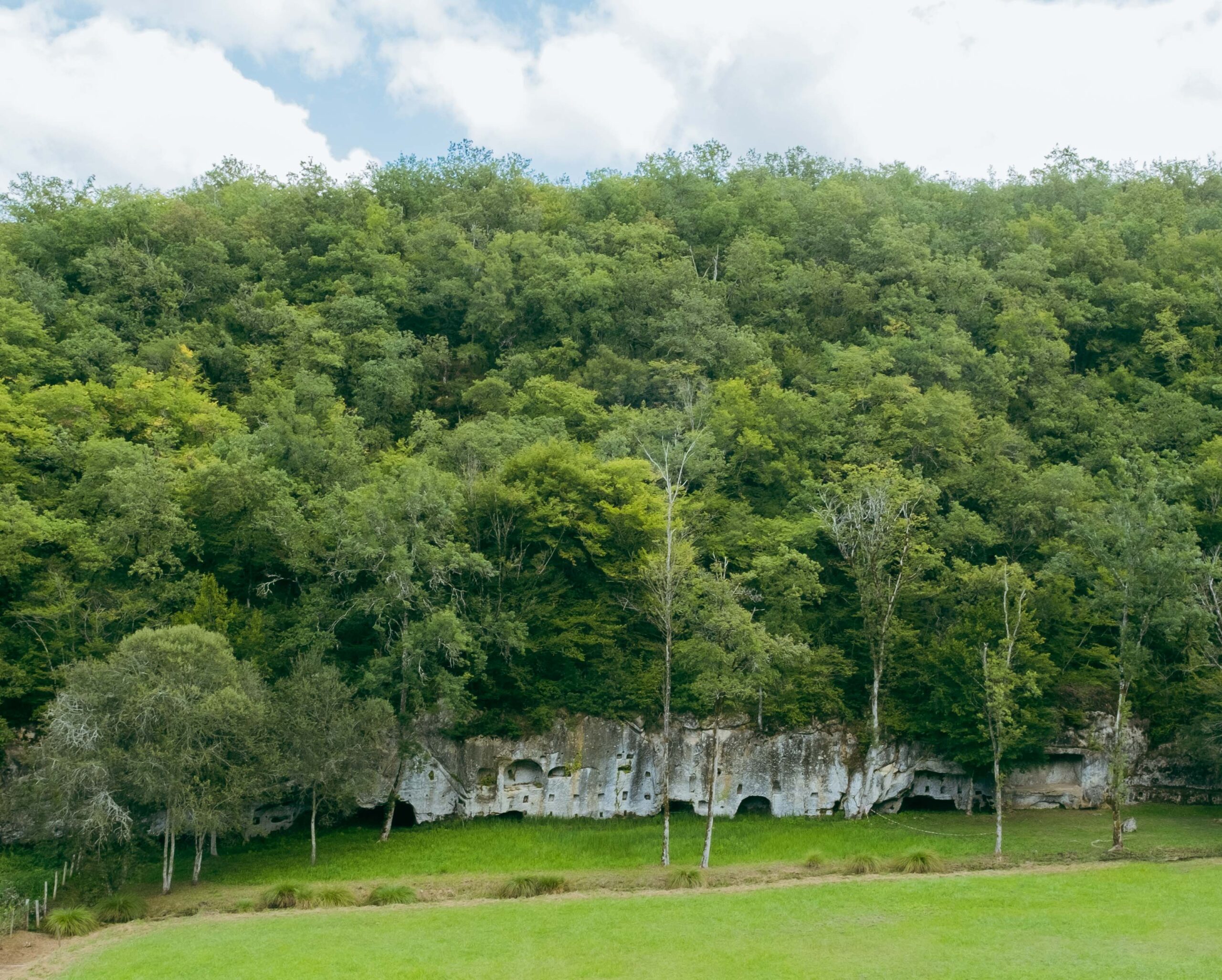
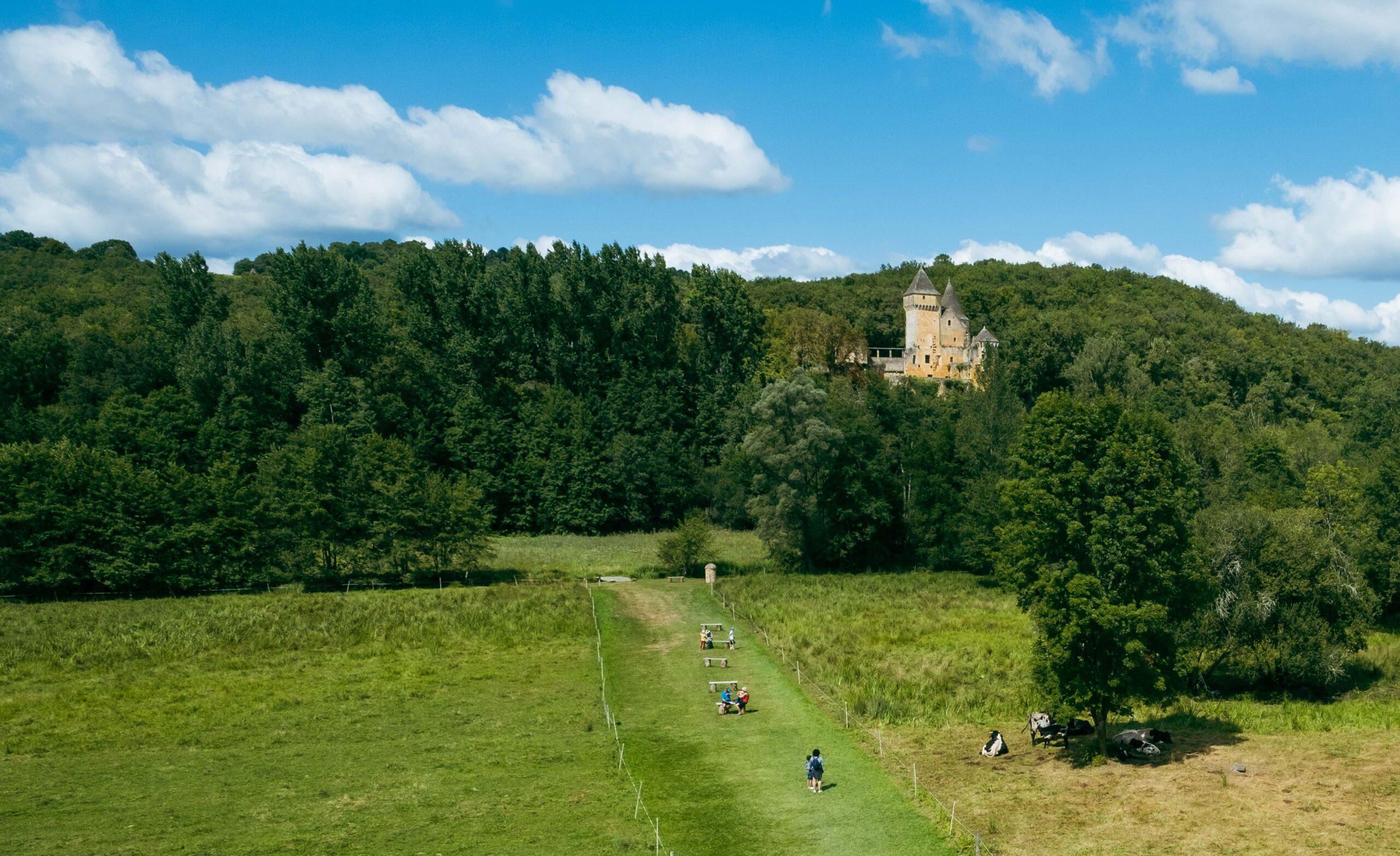
The 1st thing to know about Commarque: how OLD this place is!
The man selling admissions on the day of my visit advised me to “start at the bottom and work your way up to the top” of the site – and it was good advice. The first thing that is clear about the site at Commarque is that it is not just a grand medieval ruin – this place is truly ancient. Like the cave dwellings we saw at La Madeleine, the caverns in the rocky base of the castle’s footings have been occupied by humans off and on for perhaps 14,000 years (although it is possible that this could be more like 18,000 years). The Grotte Ornée beneath the château is deeper than many of the others found in this area, and (according to Commarque’s website – the cave is closed to visitors) the walls are decorated with dozens of engraved images of animals, people, and fertility symbols.
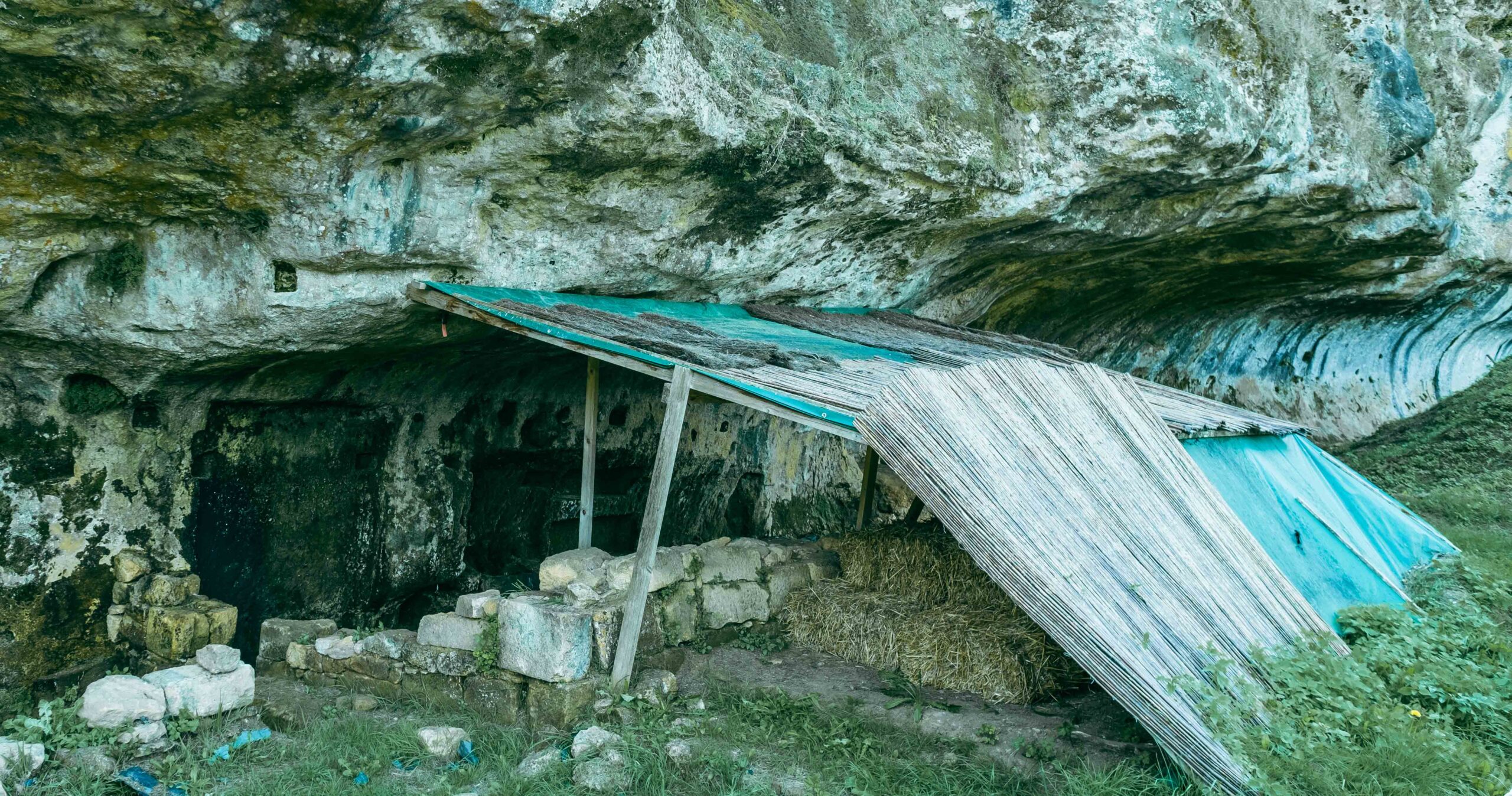
Karen and I have had the thrill of being among the very few visitors allowed in each day to see the prehistoric paintings on the wall of the caves at Font de Gaume and Combarelles, and I’ve spent a very intense day at the French National Museum of Prehistory at Les Eyzies (the “World Capital of Prehistory”). Clearly all these sites (including the nearby famous cave at Lescaux) were spiritual centers for our prehistoric ancestors and being around them generates a similar chill of spiritual mystery in me.
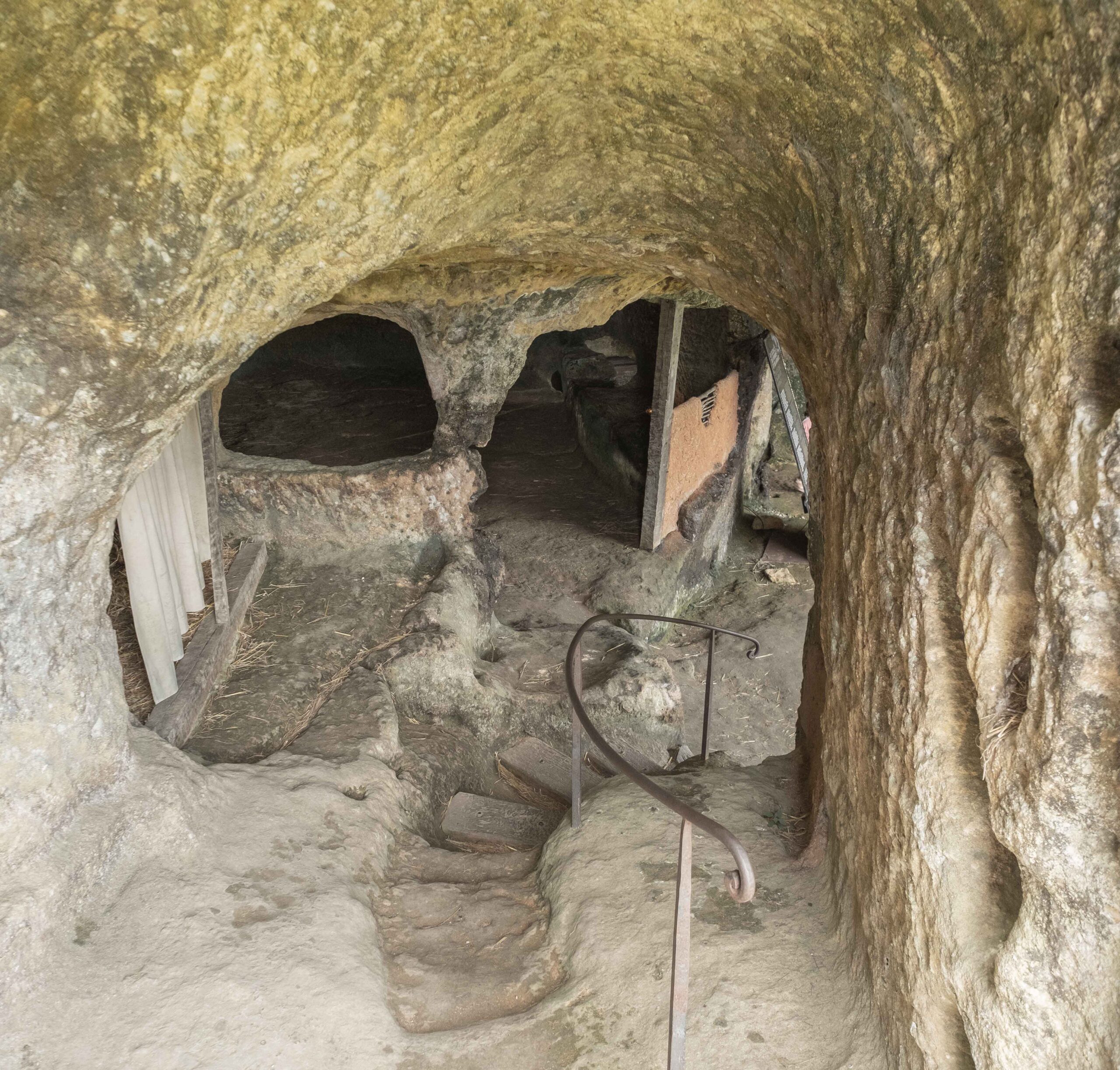
At Commarque, though, that effect is compounded as you start the climb up the stratified levels that make up the château. Here there are slippery, steep rock paths down into other troglodytic chambers carved out of the limestone.
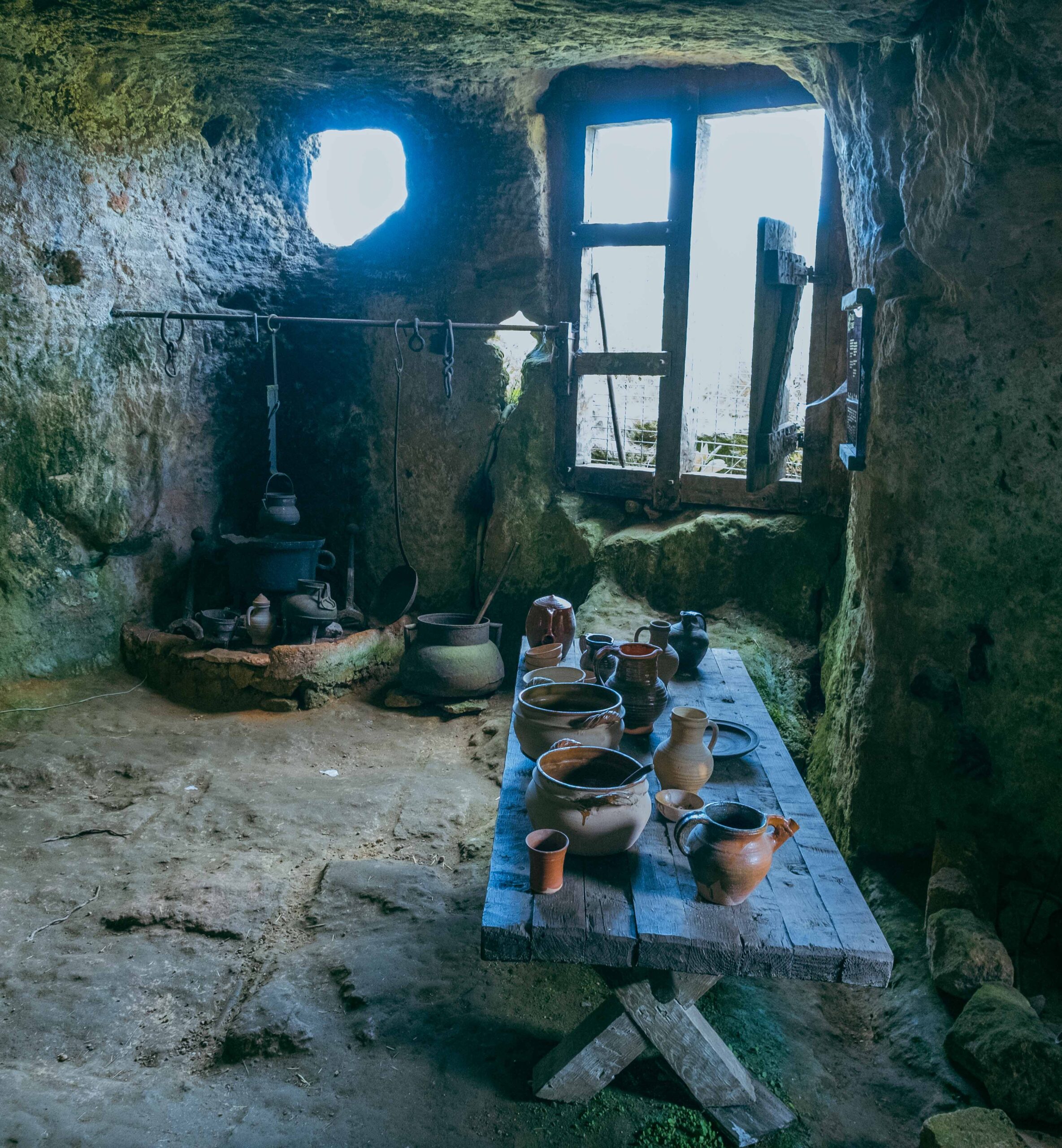
Now, though, you can see them fitted out with furniture, and it’s possible to imagine people seeking shelter here as early as the 800s C.E., or soldiers standing guard for the castle in the Middle Ages, and again the effect, for me, was powerful.
The 2nd thing to know: Commarque’s life as a medieval stronghold
Given its long prehistoric life, the complex of buildings that make up the Château de Commarque today must seem almost “modern”. But in fact, the site began to be developed in the 12th century, and the ruins we see now were largely finished by the 14th century. Again, though, this is no ordinary castle! Like the fabulous Tours de Merle, the “gated community for aristocrats” I visited a few years ago, this was likely a “co-seigneurie” – really a fortified village containing the rich homes of six noble families.
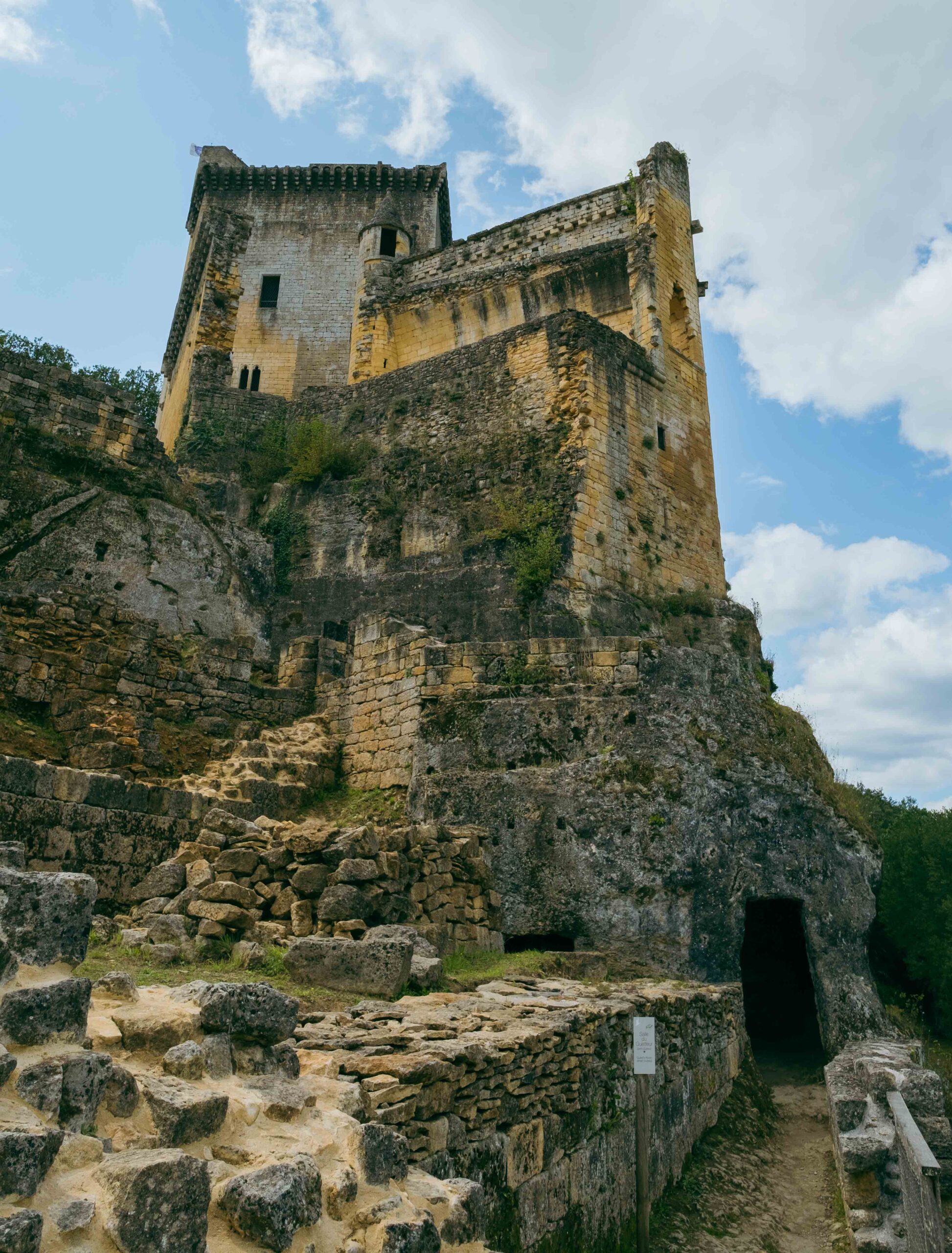
One of these was the powerful Beynac family – already the holders of one of the most impressive heavy fortresses in this part of France, but the Commarques, the Cendrieux, the Gondrix, and the La Chapelles had luxurious residences there, too. And like so many of the great castles of the Dordogne, this fortress was frequently attacked; it was taken over by the English in 1406 (during the Hundred Years’ War), and again by Catholic armies in 1569 during the Wars of Religion.
Only fragments of the great houses remain on the site today – a wall here, a panel of gothic windows there, and what must have been a fine small chapel. The pathways connecting these ruins are rocky, rough, and definitely not “accessible”, but if you’re up for a sharp climb, they are worth the effort. Of course, the crowning glory of the castle is its donjon, now restored, rising 80 meters above everything else in the village.
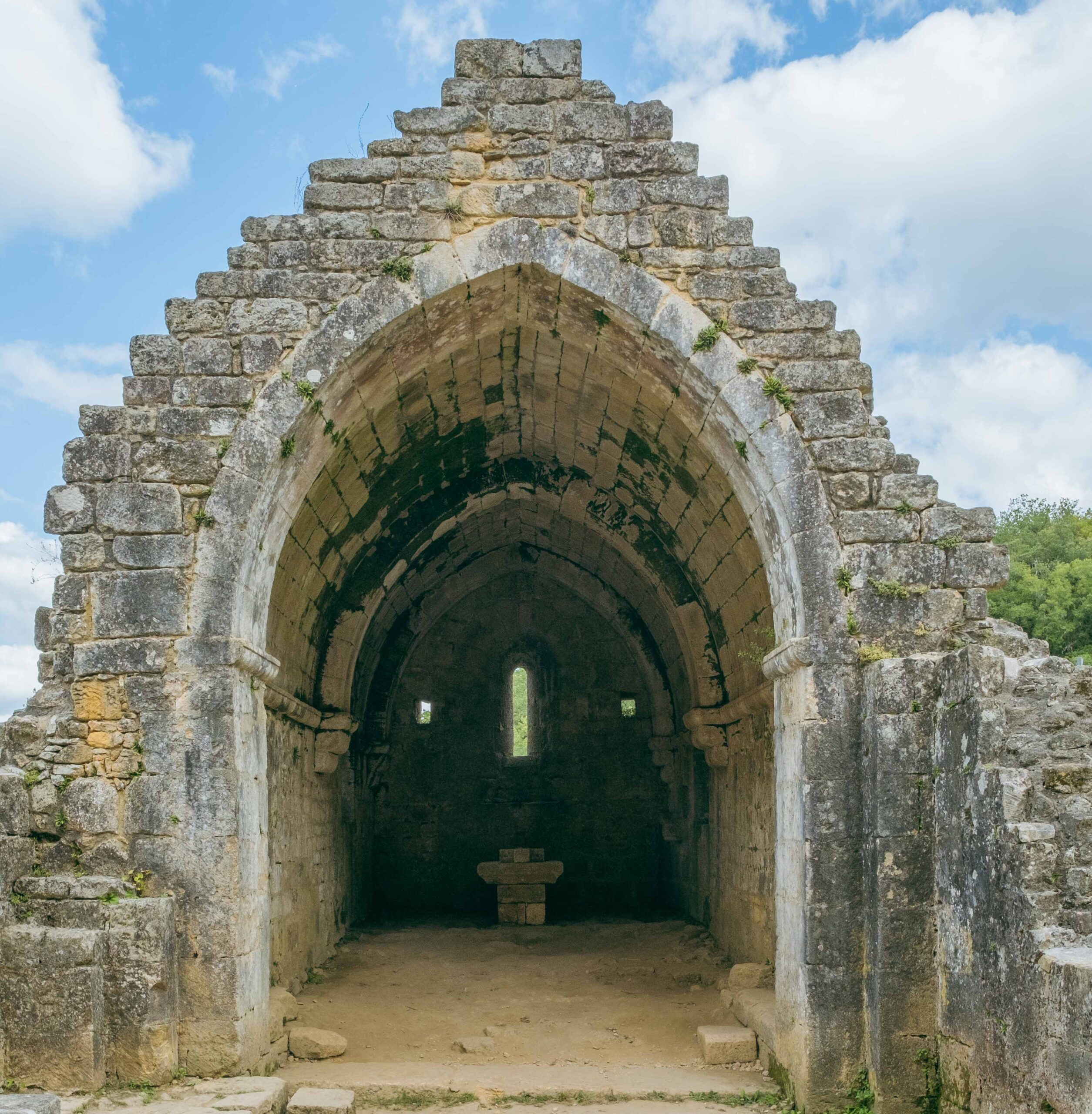
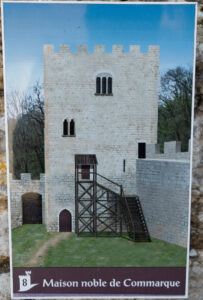
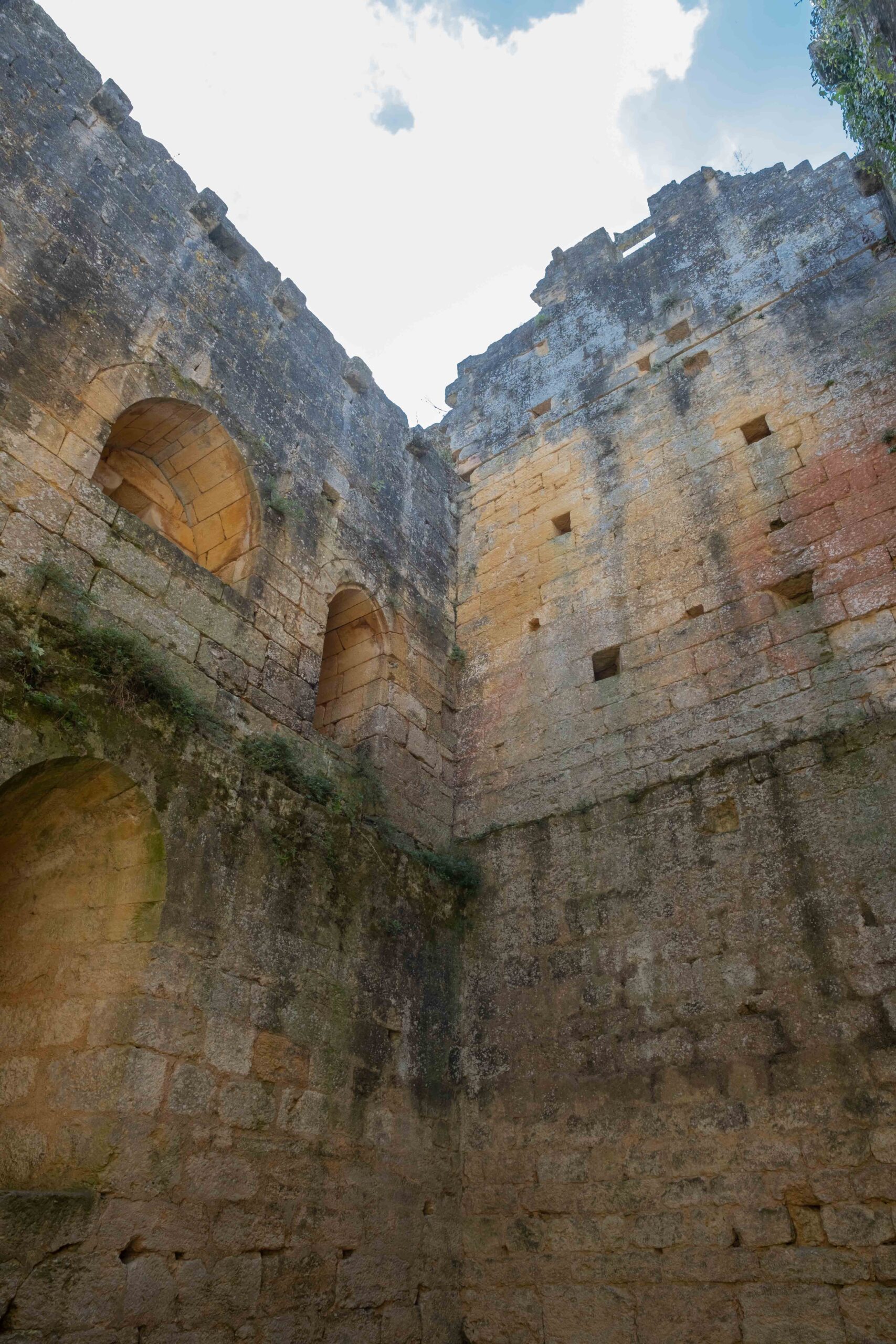
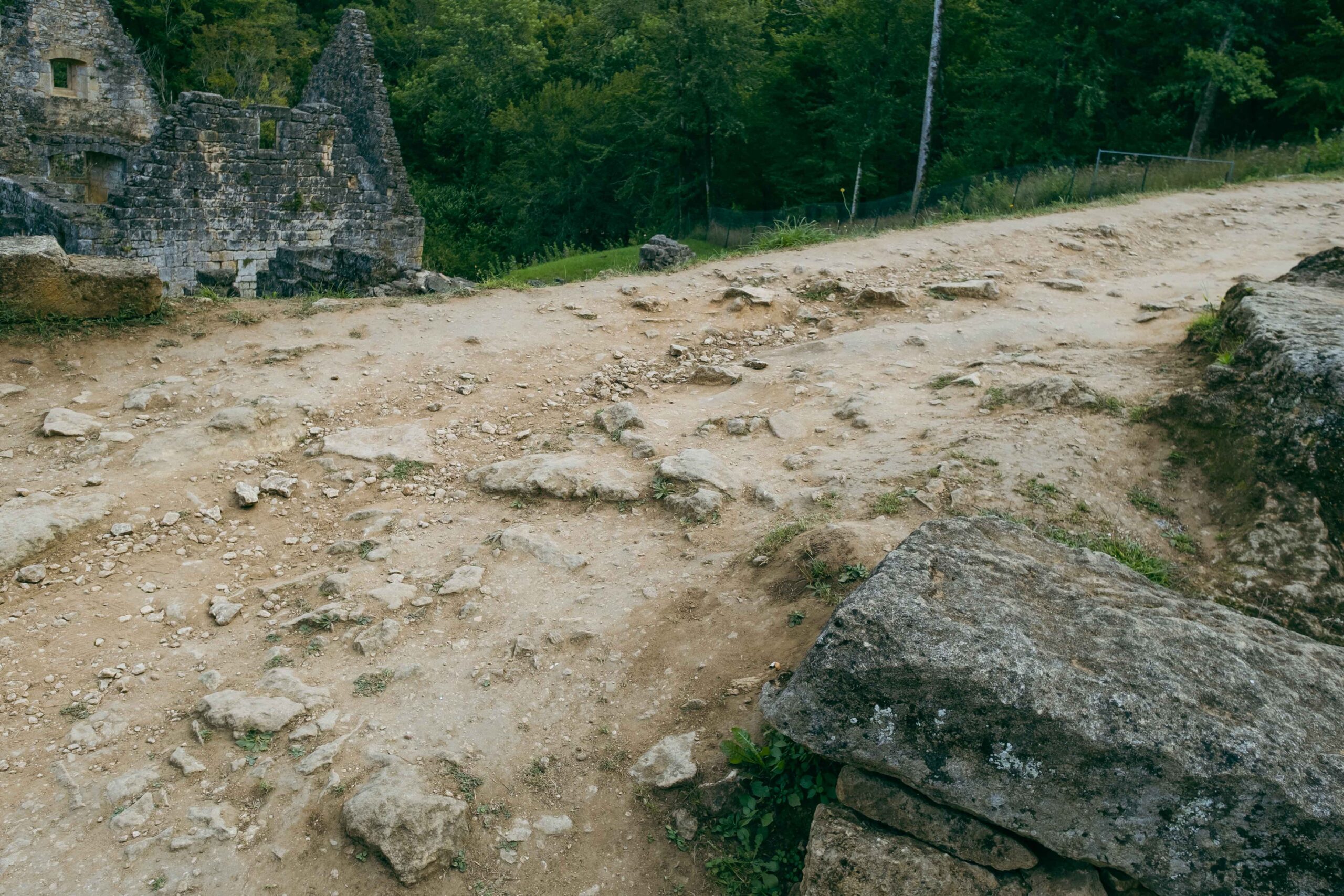
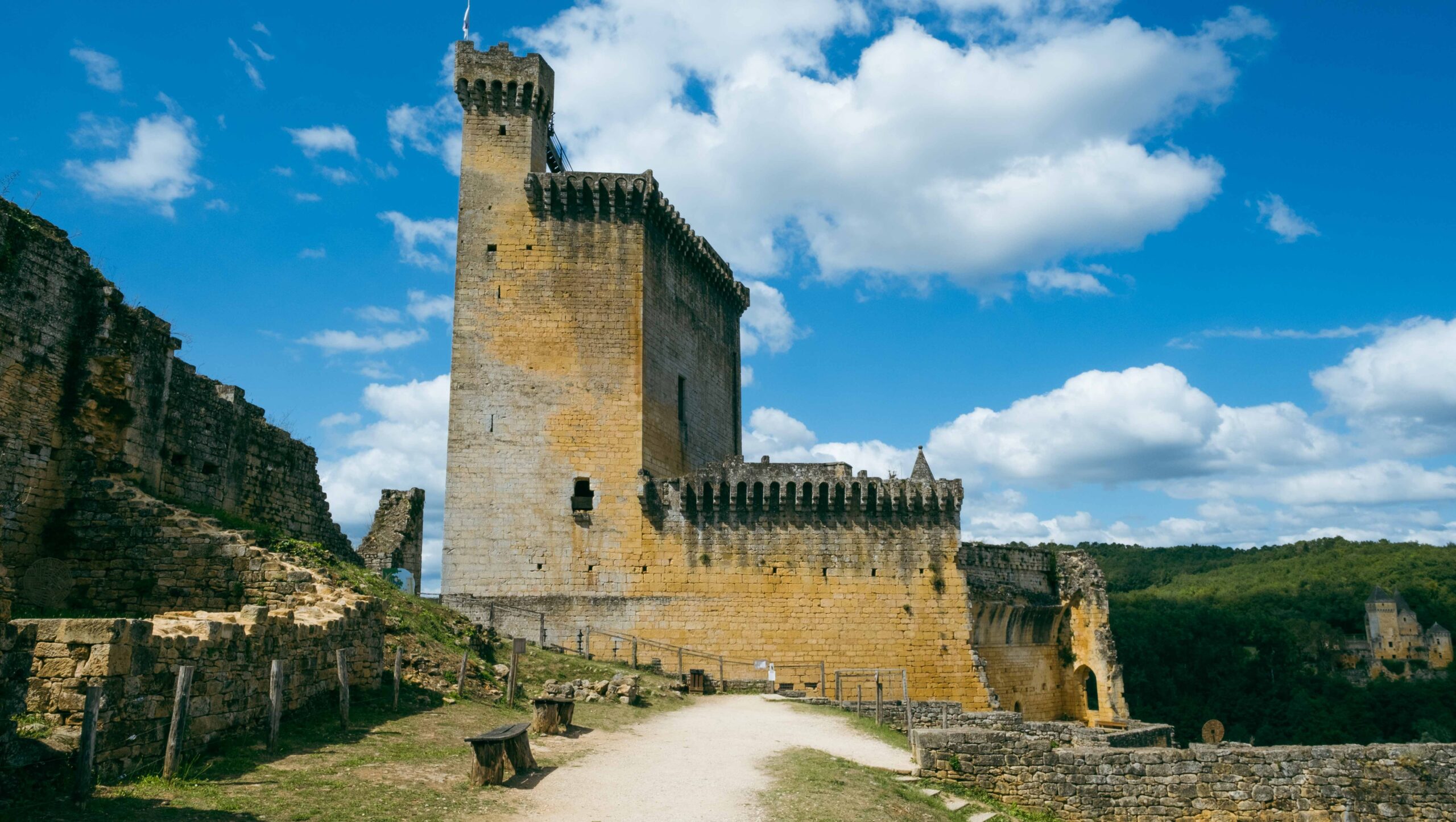
The 3rd thing to know: legends about Commarque magnify its reputation
So, even superficially, this is a site with an incredibly long, rich history. But the story doesn’t stop there – in fact, it gets exponentially more interesting for a history nerd like me! The guy that started the construction of this château was Gérard de Commarque. In 1116, he entered the famous order of the Knights Hospitaller as one of its early members. When he left for Jerusalem to join the Crusades, he donated his properties to the Hospitallers, thus establishing a link to that organization that has endured, at least in popular imagination, over the centuries. Eventually the Château de Commarque became one of several commanderies of the Knights Hospitaller, and when the mighty Beynacs took over the site they also inherited the commanderie.
In fact, the first time I learned about this place was through a novel by Martin Walker, The Templars’ Last Secret. (It’s one of Walker’s Inspector Bruno series of murder mysteries; if you’re interested in life in the Dordogne, I recommend several of the books in this series for the way they depict the food, drink, culture, and general rhythm of living in this region of France!) To be clear, the Templars were NOT the same as the Hospitallers – in fact, they were at best collaborating organizations and at worst, rival military forces. But both were very rich, and legends about their treasure troves abound. (I’ve read stories recently hinting that the Holy Grail itself may be hidden under one of the Templars’ commanderie houses in England, and there are thousands of other sites that claim a similar connection.)
So Martin Walker sets a murder mystery about a woman who mysteriously falls from the top of the great donjon at Commarque, and takes the literary liberty to attribute the crime to treasure hunters looking for the Templars’ lost gold.
Unlike the famous medieval fortresses of Beynac and Castelnaud that glowered at each other across the Dordogne as they had during the Hundred Years’ War between the English and French, Commarque was not on the standard tourist route. Its remoteness somehow added to its grandeur. The outer walls enclosed a large village that contained the remains of six grand houses, each inhabited in the Middle Ages by a different noble dynasty, while the Commarque family held the main keep with its high tower. Bruno had heard the ensemble described as a kind of holiday camp for the feudal elite, a place where they would gather for celebrations and feast days to scheme and plot and arrange marriages while enjoying the magnificent view over the valley of the River Beune.
Martin Walker, The Templars’ Last Secret
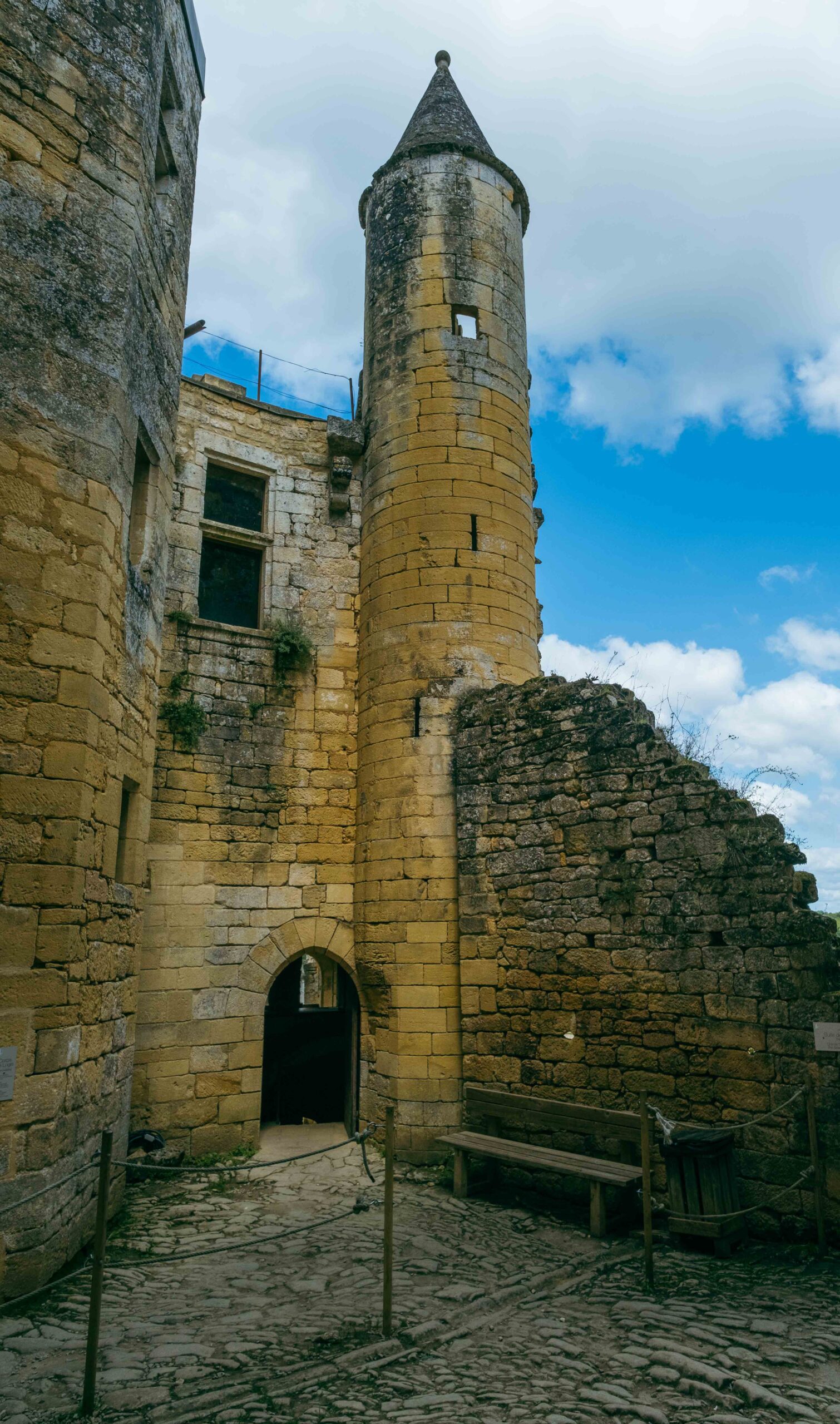
That was the description that first sent me off to research the site and eventually took me there on a brilliant summer morning. But it’s not the only time the château has appeared in popular culture. When Ridley Scott directed his first movie, The Duelists, in 1977, he set the climactic duel scene at Commarque. The French novelist Robert Merle said the castle inspired locations in several of his historical novels, and it has made appearances in at least 8 other films or television series.
The 4th thing to know: how a “forgotten” site was brought back to life
Again, all of this would have been reason enough to attract me to this great village of ruins – but once I was there, I learned another remarkable part of the story that, for me, sealed this is as one of the most interesting places I’ve ever visited in the deep heart of France. You see…all of this was almost lost altogether as recently as the 1970s.
The noble families abandoned their mansions beginning in the 1500s, and over time things naturally fell apart. Although a Catholic priest discovered the prehistoric Grotto and its rich inventory of ancient cave art in 1915, the whole site was sold to a minor German noble in the early 1900s and he started carting off pieces of the ruins, essentially using the old village as a quarry for building his own mansion near Sarlat-le-Caneda.
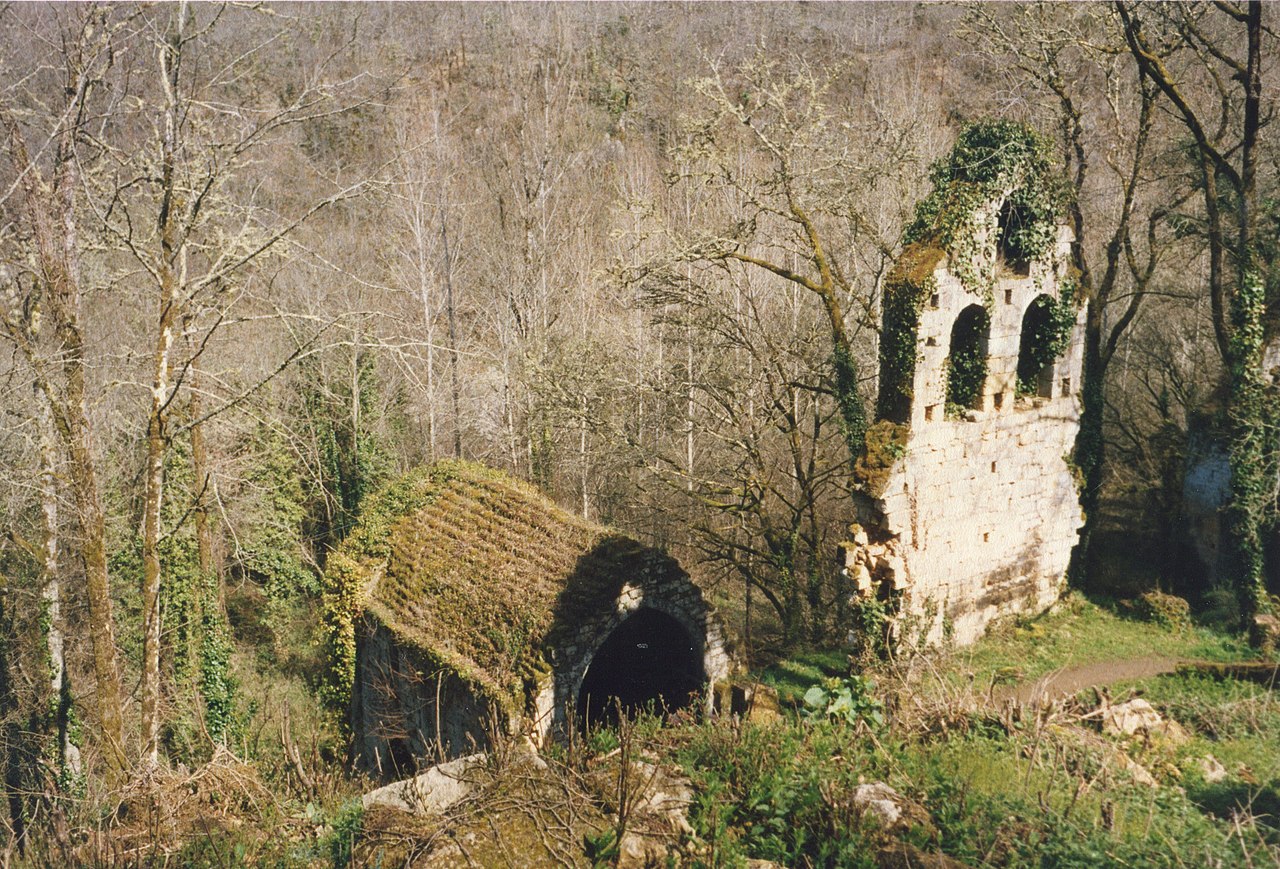
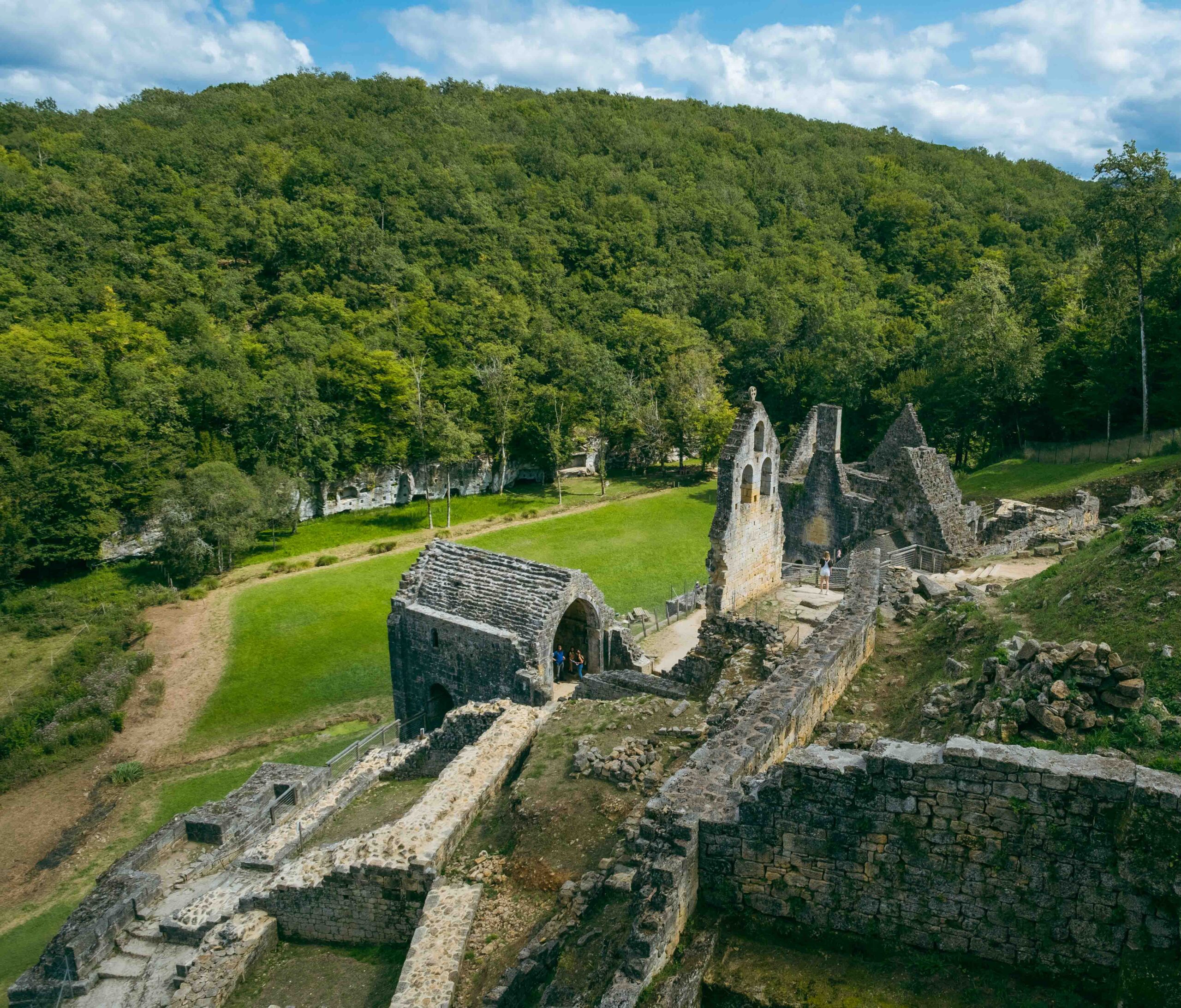
The decay continued, and the château was almost completely swallowed up by the surrounding forest, until Hubert de Commarque – a genuine descendant of that historic family – bought the place in 1968. Here’s how he describes what he found there:
It seemed destined to become only a shapeless mass, a once legendary place where, by our own time, practically all of the bits of building still standing would gradually have collapsed. […] For the last 50 years, I have worked non-stop on clearing away the vegetation and piles of rubble, gradually uncovering the alleyways and steps carved into the rocks, as well as the remains of houses that had been engulfed.
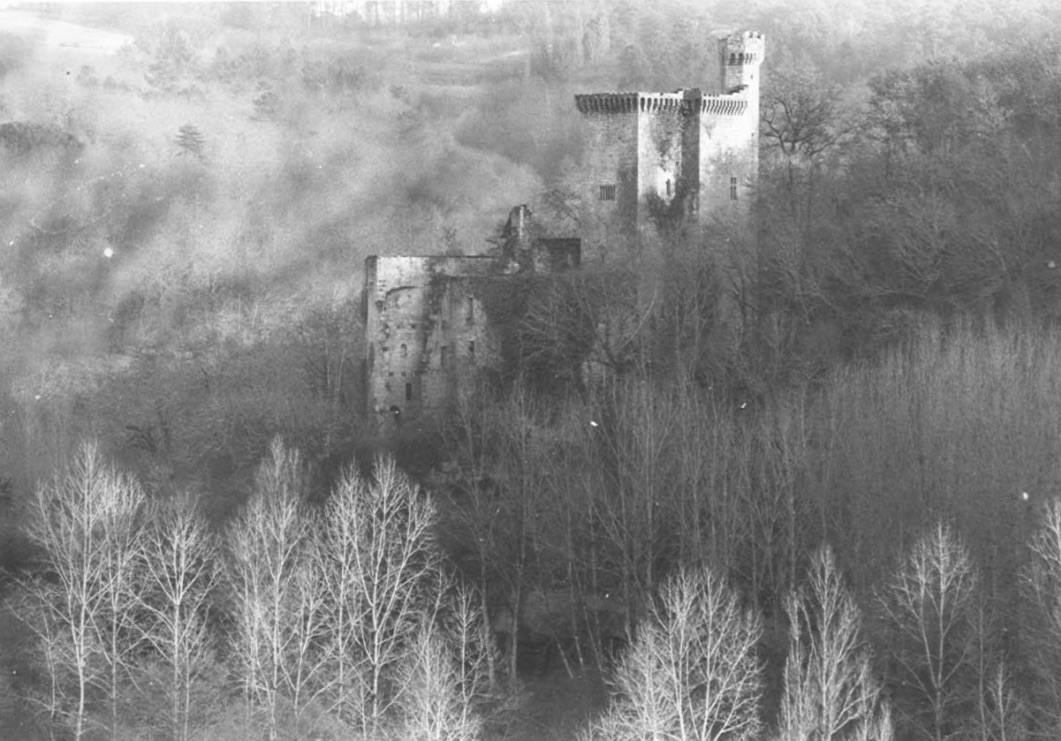
M. de Commarque’s devotion to this mission is extraordinary. The most visible project today is the faithful, high-quality restoration of the great donjon at the top of the ruins, but throughout your visit you can see how the work will proceed on the remains of the six noble houses, the chapel, and other common areas of the fortified village.
(You can see a short interview with M. de Commarque and appreciate his passion for the restoration of his family property in this video.)
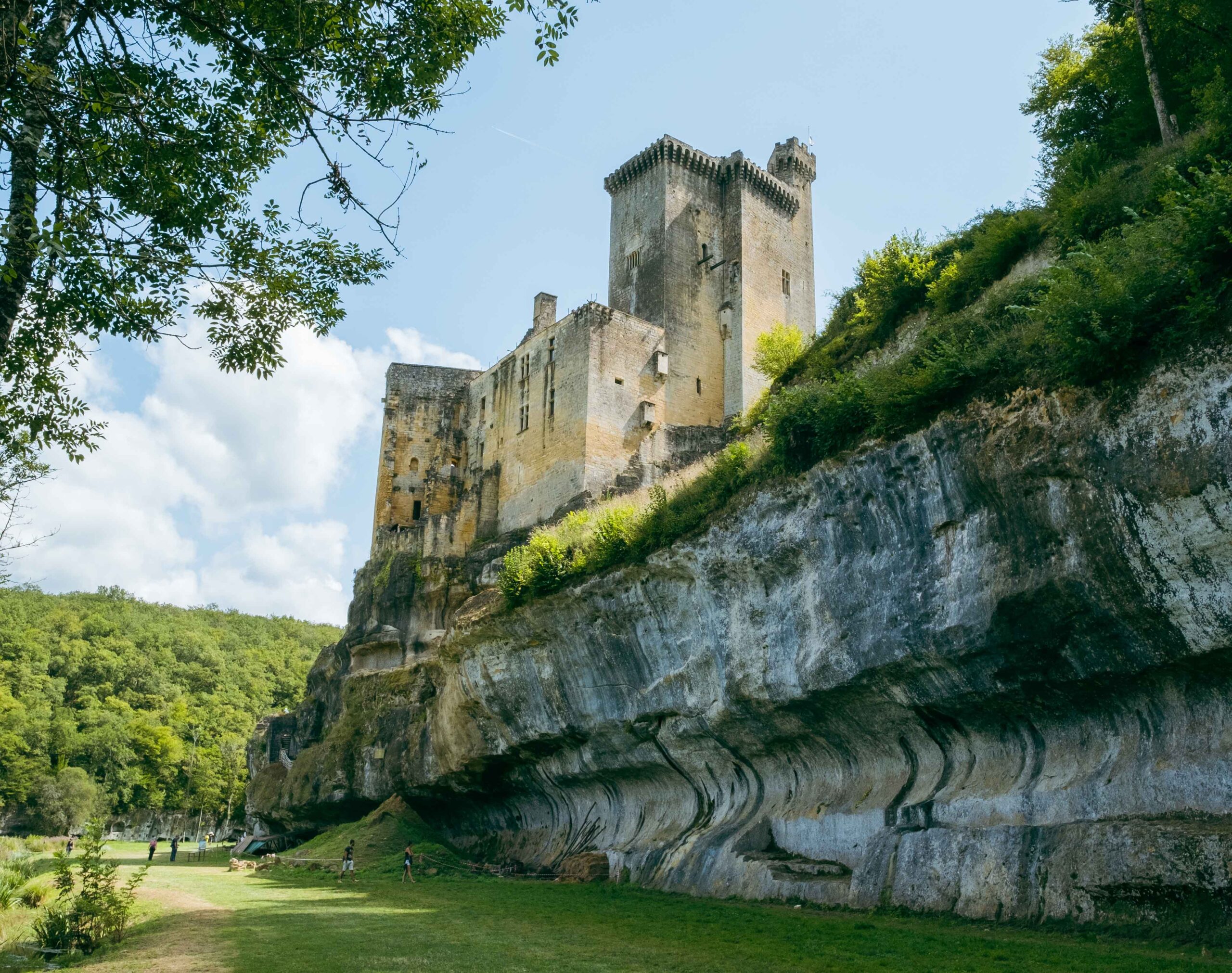
Visiting Commarque today
All this reconstruction work is expensive, so the château has a full program of workshops and events to bring paying visitors to the site. It has been open to the public since 2020, and you can go for €9.30 for adults, €5.50-6.50 for children. That ticket price includes a self-guided tour (available in 6 languages) and all the films and expositions available during the visit. If you go on holiday weekends or school vacation times, there are also several workshops for the kids – an archery lesson, tracings of medieval cave art, handwriting with a feather plume, and so on.
_________________________________
Click here to go the the Château de Commarque's official website
__________________________________
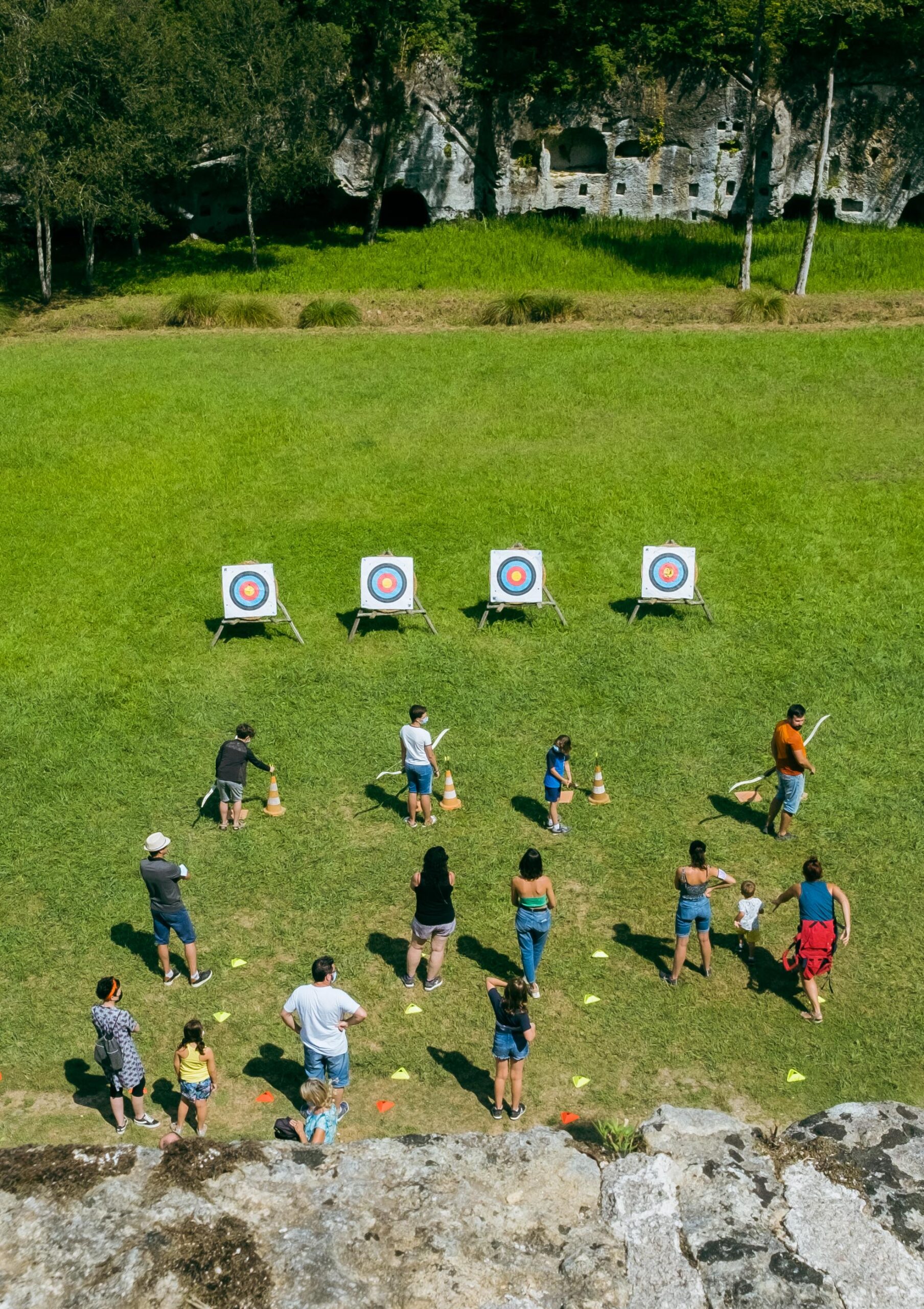
Grown-up visitors might prefer the Escape Game mounted by the castle’s staff during April and May (by reservation only), or you might try their murder-mystery evenings. (Shades of Martin Walker!) If you’re REALLY adventurous, they will even let you rappel 60 meters down the outer wall of the donjon (under the supervision of experts) for €25 per person!
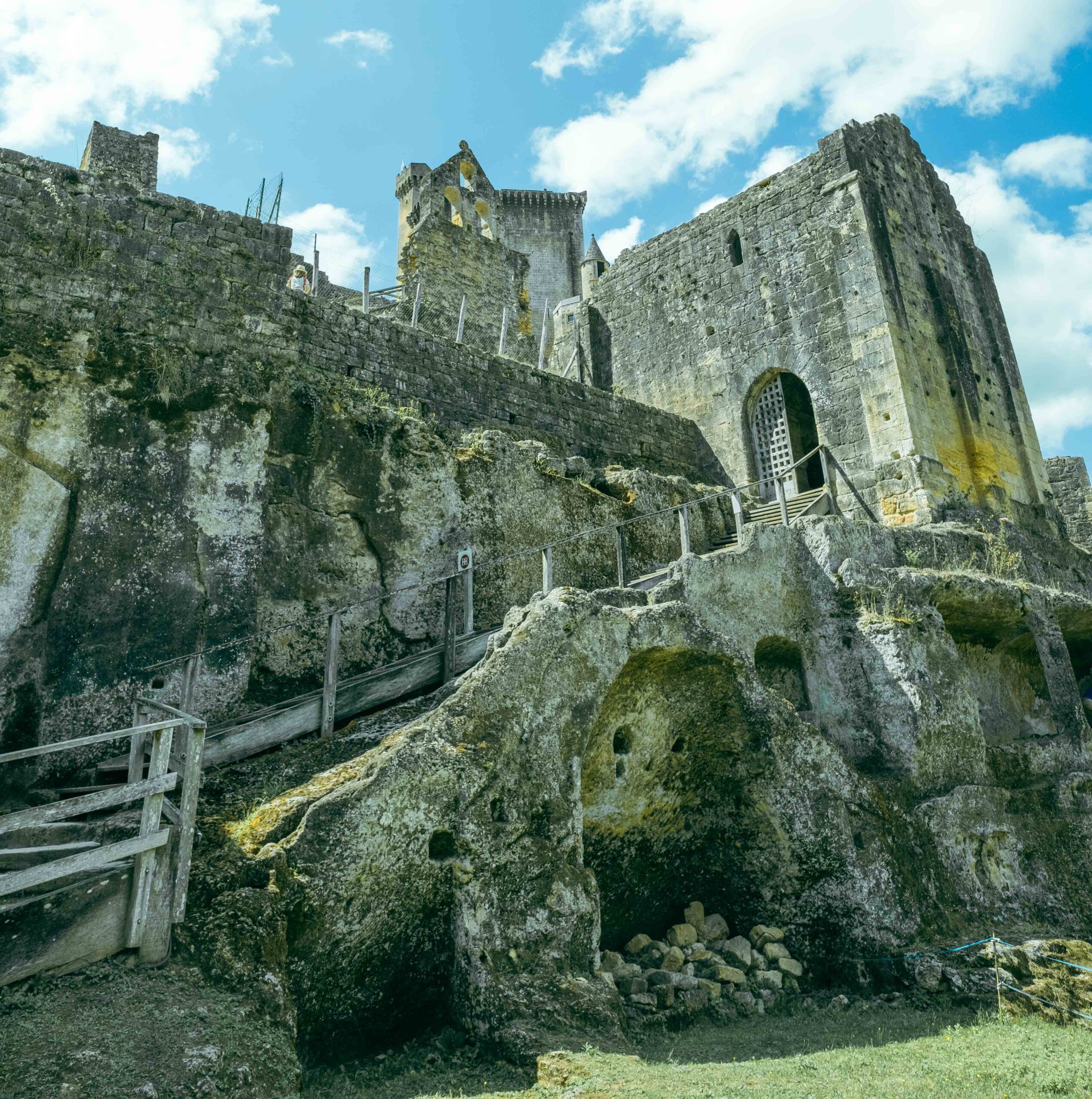
But that’s the (necessary) commercial side of this incredible site. I can’t put into words everything I felt (besides “please don’t let me slide to my death!”) as I scrambled around the rocky ruins. It’s partly the physical beauty of the setting, this lush green meadow surmounted by dramatic castle walls. It’s partly the almost spiritual quality of absorbing the weight of the thousands of years of human development that envelop Commarque. And yes, for the historian in me, it’s partly the incredible story of how the château has been dragged from the jaws of total ruin and put on a path to restoration as an important place in the history of France.
In any case, I come back to what I said in the beginning: the Château de Commarque is unique among my most moving experiences of traveling in the deep heart of France, and I heartily recommend the journey there to anyone who has the opportunity!
Have you ever visited a place that moved you in this way? What specifically speaks to you in the presence of these ancient ruins – why do you think they are worth a visit? Please share your experience in the Comments section below – and while you’re here, please take a second to share this post with someone else who is interested in the people, places, culture, and history of central France.
Unless otherwise noted, all photos in this post are copyright © 2021 by Richard L. Alexander. All rights reserved.
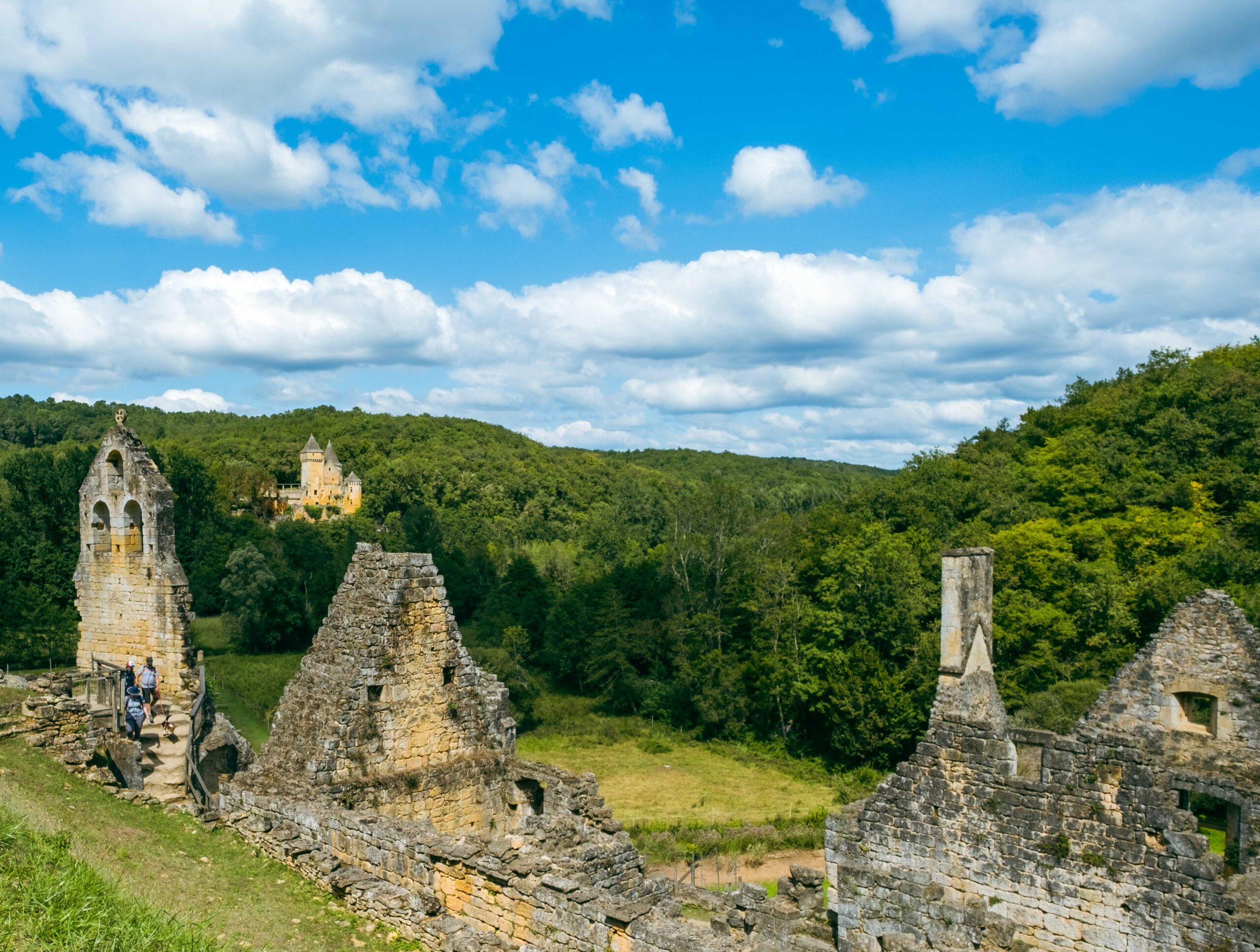
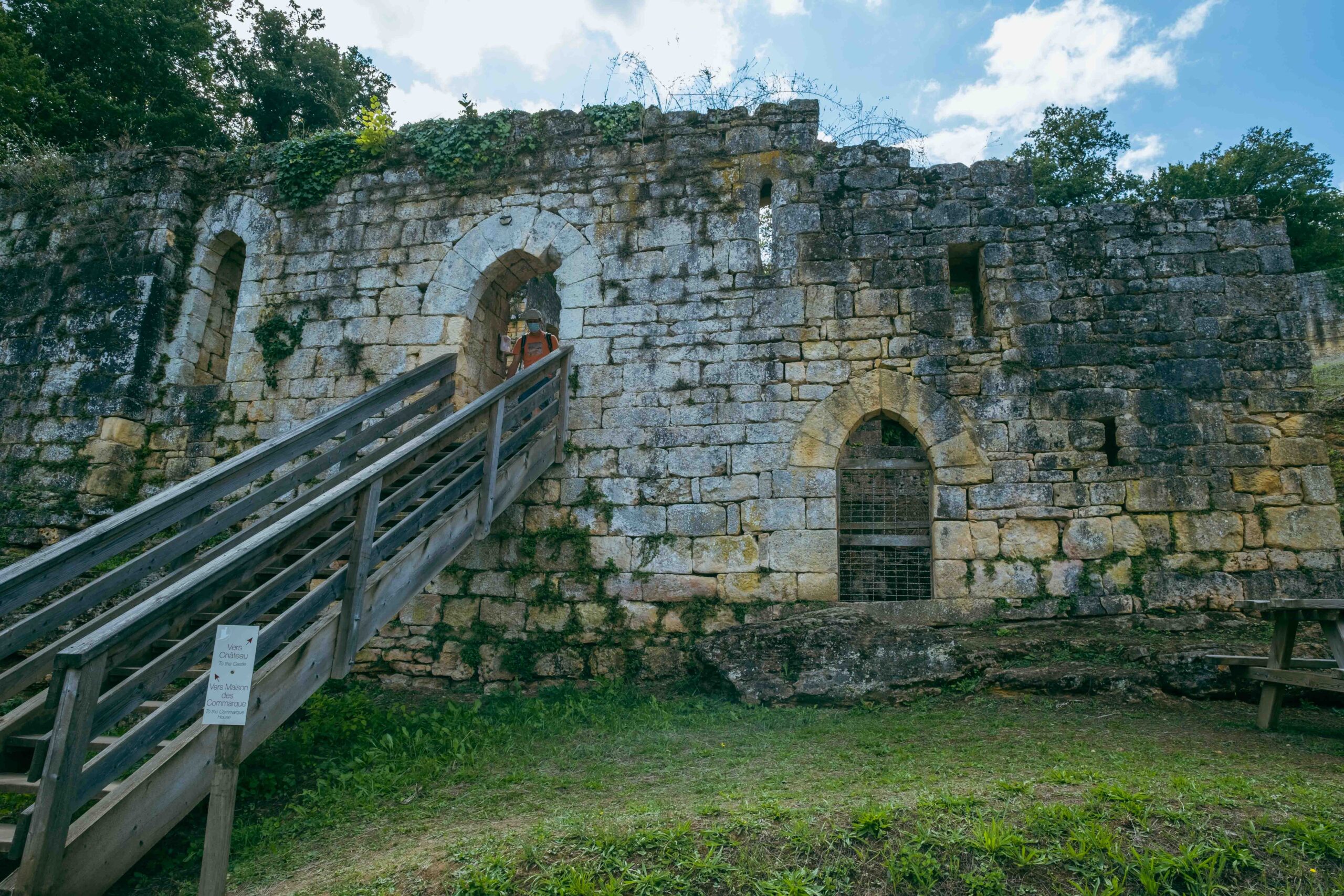
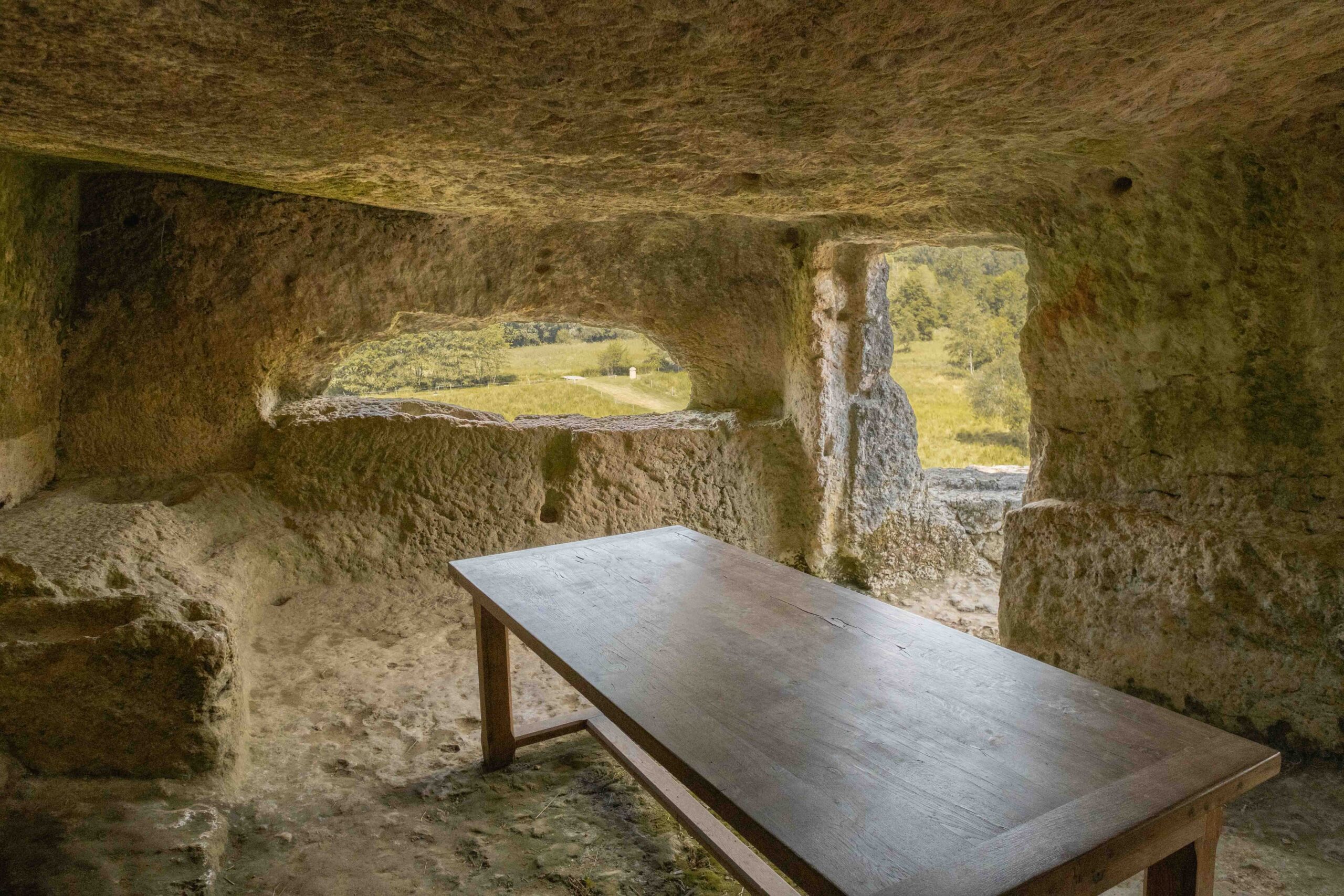
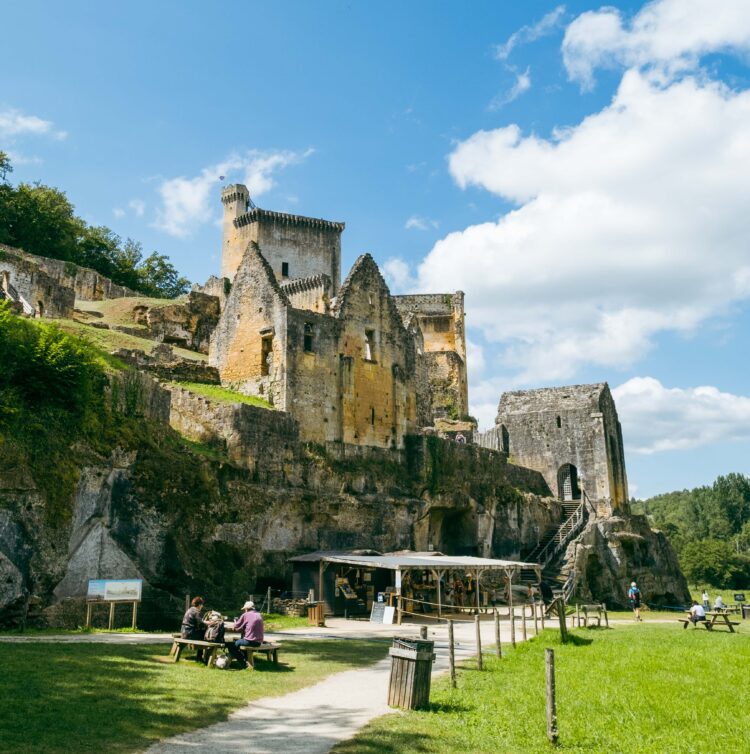

Beautiful story on Commarque, thank you. Such great details and insight. We’re sure to plan a visit in June.
Thanks so much, Judy. I’d be interested to hear what you think when you visit!
thank you richard for your excellent comment always on top! I always take great pleasure in reading you I compliment you
have a nice day
Merci beaucoup, Christian! It is always good to hear from you!
Hi Richard
My husband and I happened upon this place Christmas day 2016 while staying nearby. We pulled into the carpark and nearly gave it a miss. My poor hip was knackered and I was in a lot of pain. But boy oh boy was it worth it. It wasn’t open to visitors but we were able to have a good look around the outside.
For a couple of Kiwis from New Zealand with not a lot of history this was and has been the best Christmas day ever! Give me a D road any day!
A really interesting read. Would live to go back in the summer time.
Suzy
Thanks for writing, Suzy! I don’t know what it is that makes winter travel in France so appealing, but we agree with you that some of our best experiences happened in the off-season. (I’m thinking of a birthday weekend with our son in Mont Richard, or the bitter cold in February when we visited Rocamadour.) And it’s true that, with Commarque, you can get an incredible impression of the place even if the gates aren’t open to visitors. I’m glad you have such wonderful memories of your experience there!
I sent this email to some friends just yesterday(27th Sep 2022) but then came across your article and thought it might be of interest to you.
Dear..
This was meant to be a postcard but I got carried away and wrote too much, so I had to send it as a generic email instead (Jacqueline suffered the same fate with a card I sent her last week). It’s all to do with translating French into English.
In English if no word currently exists we invent a new one (woke, meme, goat, boomerang generation). In French they seem use more adjectives or adverbs or borrow an English word (le parking, le weekend, le sandwich).
I was reminded of this when we came here (Boussagou)
In 1996 Maureen, Jacqueline and I went for a walk in the woods near Montignac where we were based. In a secluded valley and almost hidden by forest, vines and brambles we came across the ruins of a massive ancient fortress. It was a magical moment and we explored like Indiana Jones. It was like finding an unknown Aztec temple in the jungles of Guatemala or Mexico. (It was private land and we were trespassing, though we didn’t know that at the time and I have some recollection that it’s not an offence in France)
Fast forward almost 30 years and the woods have been tamed, the ruins excavated, restored and opened to the usual boring guided tour. The majesty of the site remains but the magic has gone.
In one guidebook here, there is a description of the chateau in French, followed by an English ‘translation’.
The English part reads: “Well preserved valley, breathtaking view, dungeons, fortified castle, cave dwellings, lots of fun”. (Reasonably accurate and very concise)
The French says:’ Il etait une fois, dans une vallee, preservee un grandiose millefeuille de pierres, ou donjons et chateau fort, troglodytes et grotte prehistorique se superimposent sur un eperon rocheux dans un paysage a couper le souffle” (all accents missing and not at all concise!)
I translate this (loosely) as :”Once upon a time, in a valley, a monumental array of tumbled stones revealed the remains of castle walls, a keep, prehistoric caves and troglodite dwellings standing on a rocky spur in breathtaking scenery” (which is a fairly accurate description but expressed with typical French exuberance)
Note: mille feuille literally translates as 1000 leaves and is often used to describe filo pastry. And a donjon is the keep or main building of a castle and not a dungeon. A couper le souffle is ‘to cut the breath’. Il etait un fois means ‘there was a time” or simply ‘once’. The remains are hardly ‘grandiose’ but monumental, yes.
I’ve added a couple of photos of the Chateau de Commarque today. You must use some imagination to envisage how it appeared in 1996. Note, in the last photo, it is described as ‘the mysteries of the forgotten fortress.”
Hope I haven’t bored you too much!
Bonjour Keith. I’m really grateful that you shared this. When I visited Commarque I was most intrigued by the places on the site — especially the chapel — that had posted pictures of how this all looked when it was still overrun by forest and vegetation. I can only imagine how exciting and (as you say) magical this place must have looked when you first encountered it in 1996; I wish I could have seen it then! Again, thank you.